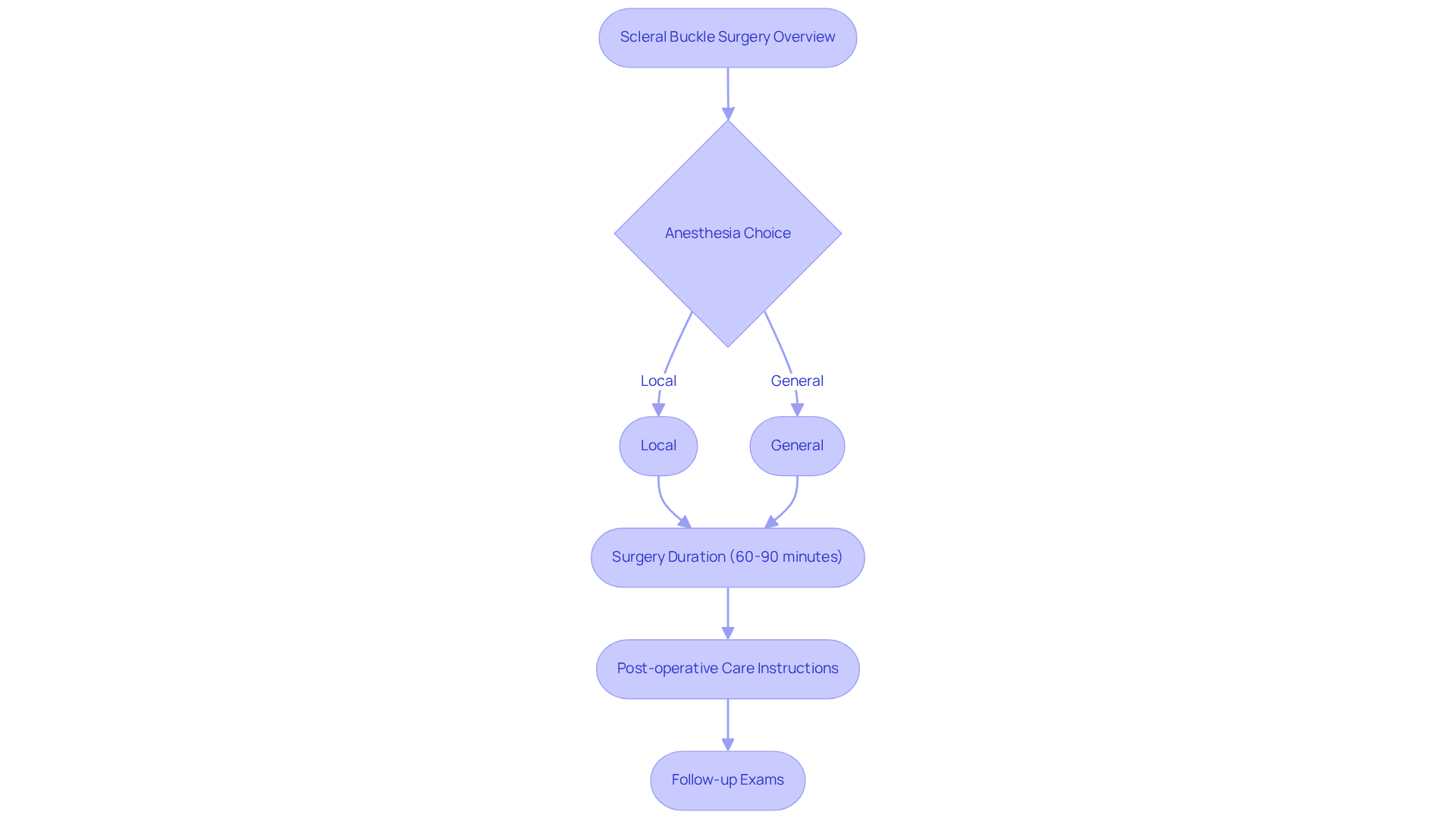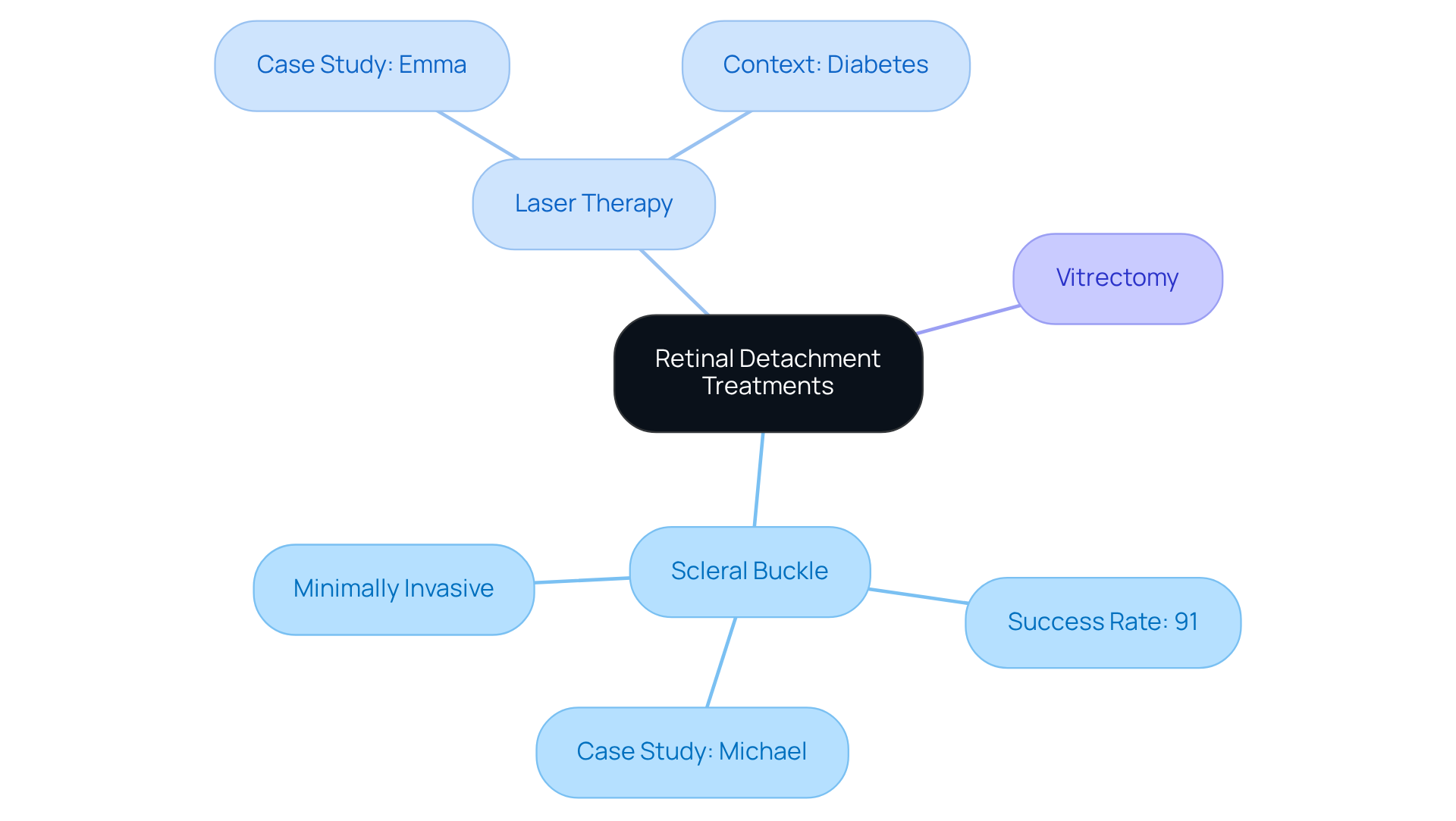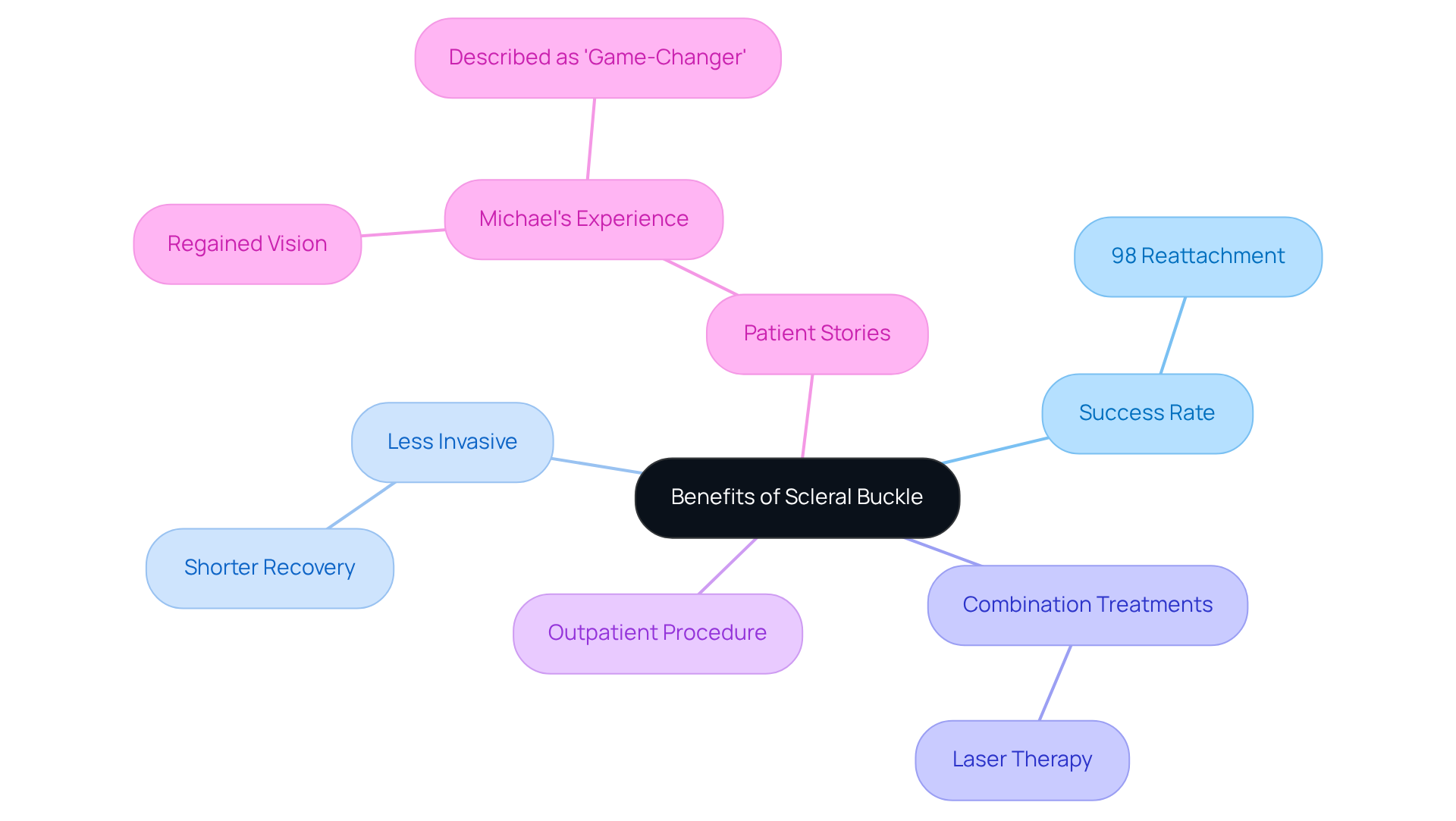Posted by: Northwest Eye in General on July 26, 2025
Overview
We understand that facing retinal detachment can be a daunting experience. The scleral buckle plays a crucial role in your treatment by physically supporting the retina and promoting its reattachment, boasting a remarkable success rate of over 90%. This minimally invasive procedure not only enhances vision restoration but also significantly improves your quality of life. Many patients have shared their positive recovery stories, illustrating its effectiveness compared to other treatment options. We are here to help you through this process, ensuring you feel supported every step of the way.
Introduction
Retinal detachment poses a significant threat to vision, and we understand that it can be a distressing experience. Immediate and effective intervention is often necessary. Among the various treatment options, scleral buckle surgery stands out as a minimally invasive yet highly effective solution, boasting impressive success rates in reattaching the retina. As advancements in surgical techniques continue to evolve, many wonder how this procedure not only restores vision but also enhances the overall quality of life for those affected.
Exploring the intricacies of scleral buckle surgery reveals its pivotal role in combating retinal detachment. This procedure can transform patients’ lives, offering hope and a path to recovery. We are here to help you through this process, ensuring that you feel supported every step of the way.
Define Scleral Buckle: An Overview of the Procedure
surgery is a crucial operation aimed at treating , a serious condition where the retina separates from its supportive tissue. We understand how concerning this can be. This , known as a ring, around the eye, creating an indentation in the sclera, the white outer layer of the eye. This indentation gently pushes the retina back into contact with the underlying tissue, promoting its reattachment.
Typically performed as an outpatient procedure, the surgery involving a scleral buckle can be done under local or general anesthesia, depending on the complexity of your case and your specific needs. The surgery usually lasts between 60 to 90 minutes, allowing you to return home the same day. We recognize that is vital; you will receive specific instructions to help promote healing and minimize complications.
Recent advancements in eye surgery involving the scleral buckle have refined techniques and materials, leading to a of approximately 90% for reattaching the retina. Many individuals who have undergone this surgery share transformative experiences, often mentioning significant improvements in their vision, which enables them to return to their regular activities and hobbies.
Current best practices highlight the importance of and personalized . This includes using eye drops to prevent infection and scheduling regular follow-up exams to monitor your healing progress. By understanding the surgical technique and its role in addressing retinal detachment, you can make informed decisions about your and treatment options. We are here to help you through this process.

Contextualize Scleral Buckle: Role in Retinal Detachment Treatment
is a serious eye condition that can lead to permanent vision loss if not treated promptly. We understand that facing such a diagnosis can be overwhelming. Nearly two million retinal surgeries are performed globally each year, highlighting the prevalence of this condition and the necessity for .
Various treatment methods exist, including:
- Laser therapy
- Cryotherapy
- Vitrectomy
However, the remains one of the most effective methods for reattaching the retina, particularly in cases where the detachment is extensive or involves multiple tears. This method is often favored for its minimally invasive nature and its capacity to offer immediate assistance to the retina.
By forming a physical indentation in the eye, the supportive device alleviates traction on the retina, facilitating its reattachment and promoting healing. With an impressive in retinal reattachment for individuals undergoing this procedure, the support device has proven to be a cornerstone in for decades. We want you to feel reassured—case studies emphasize its effectiveness. For example, Michael, a 55-year-old individual, regained most of his vision after a successful procedure that included a scleral buckle and vitrectomy for retinal detachment.
In contrast, Emma, a 40-year-old individual with diabetes, underwent laser photocoagulation and vitrectomy, which also enhanced her vision but in a different context. This comparison underscores the importance of tailored treatment options that cater to individual needs. The partnership with Retina Consultants of America further enhances the expertise available at Northwest Eye, ensuring that individuals receive the .
Furthermore, individual education resources, like the , enable people to comprehend their more effectively. We are here to help you through this process, aligning with Northwest Eye’s dedication to .

Explore Benefits of Scleral Buckle: Enhancing Vision and Recovery
The eye support procedure provides numerous benefits for individuals facing . We understand that this can be a distressing experience, and it’s reassuring to know that the procedure boasts an impressive success rate—reattaching the retina in over 98 percent of cases. Remarkably, 90 percent of individuals have their retina fully restored after just one procedure, significantly enhancing the likelihood of .
In contrast to more invasive surgical options like vitrectomy, the external support method is less invasive. This leads to and quicker recovery times, allowing many individuals to return to their daily activities sooner, which greatly improves their overall quality of life.
Moreover, treatments such as laser therapy can be effectively combined with the scleral buckle to address multiple retinal issues at once. This comprehensive approach not only focuses on restoring vision but also reduces the risk of complications that can arise from untreated retinal detachment. Typically, this process is performed in an , making it accessible and convenient for patients.
further illustrate the positive impact of this treatment. Take, for example, Michael, a 55-year-old avid golfer who faced significant vision loss due to retinal detachment. After undergoing surgery that included a alongside vitrectomy, he regained most of his vision and described the procedure as a ‘game-changer.’ like Michael reflect the clinic’s commitment to excellence, showcasing the procedure’s role in not only restoring vision but also enhancing the overall quality of life for those we care for.

Conclusion
Scleral buckle surgery is a vital intervention for retinal detachment, a condition that can significantly impact your vision. This compassionate procedure uses a silicone band to gently reattach the retina, showcasing a remarkable success rate. By understanding the details of this treatment, you can make informed decisions about your eye health, ensuring you receive the best possible care.
We understand that facing retinal issues can be daunting. Key points throughout this article highlight the minimally invasive nature of the scleral buckle procedure, its high success rates, and the importance of personalized post-operative care. The ability to combine this method with other treatments, such as laser therapy, showcases its versatility in addressing various retinal concerns. Patient stories further illustrate the profound impact that successful surgeries have on restoring vision and enhancing quality of life.
Ultimately, the significance of scleral buckle surgery in treating retinal detachment cannot be overstated. As advancements continue to improve surgical techniques and patient outcomes, we encourage you to explore your treatment options fully. Empowerment through knowledge and access to quality care can lead to transformative results, reaffirming the essential role of the scleral buckle in preserving and restoring your vision. We are here to help you through this process, ensuring you feel supported every step of the way.
Frequently Asked Questions
What is scleral buckle surgery?
Scleral buckle surgery is a procedure aimed at treating retinal detachment, where the retina separates from its supportive tissue. It involves placing a silicone band around the eye to create an indentation in the sclera, pushing the retina back into contact with the underlying tissue to promote reattachment.
How is scleral buckle surgery performed?
The surgery is typically performed as an outpatient procedure and can be done under local or general anesthesia, depending on the case’s complexity. The surgery usually lasts between 60 to 90 minutes, and patients can return home the same day.
What is the success rate of scleral buckle surgery?
The success rate for reattaching the retina with scleral buckle surgery is approximately 90%.
What are the post-operative care instructions after scleral buckle surgery?
Post-operative care includes specific instructions to promote healing and minimize complications, such as using eye drops to prevent infection and scheduling regular follow-up exams to monitor healing progress.
What advancements have been made in scleral buckle surgery?
Recent advancements in eye surgery techniques and materials have refined the scleral buckle procedure, contributing to its high success rate and improved patient outcomes.
What should patients expect in terms of vision improvement after the surgery?
Many individuals who undergo scleral buckle surgery report significant improvements in their vision, allowing them to return to their regular activities and hobbies.






